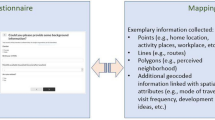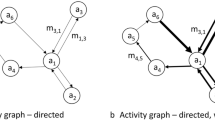Abstract
This paper reports on the development of an integrated spatio-temporal GIS toolkit that facilitates the exploration of intra-household interactions. Two tools comprise the toolkit. The first tool, Space-Time Coincidence Analyst, identifies joint activity/travel episodes undertaken by household members. The core of this tool is a set of flexible criteria for classifying episodes as either joint or independent. The second tool, Space-Time Path Visualizer, not only displays space-time paths for household members, but also shows joint episodes undertaken by any two household members together. The toolkit can be applied to any household-based, activity/travel data set so long as required information is specified by the user. To demonstrate its usefulness for research, the toolkit is applied to the TAPS (Toronto Activity Panel Survey) 2002–03 data set. The results suggest that considerable variation exists in the number of joint activity/travel episodes identified using different classification criteria. Specifically, when using restrictive criteria (i.e., same timing, specific activity type/travel mode), only 2,265 joint activity/travel episodes are identified compared to 8,791 when using more flexible criteria. In turn, our results show that certain key attributes for independent and joint activity/travel episodes (i.e., frequency per household, starting time, ending time and duration) also vary under the different classification criteria.



Similar content being viewed by others
Notes
It is unclear how a five-minute gap in arrival and departure times can produce more joint trips than a 10-min gap, as reported in Singhi (2001). One would expect either the same number of trips or more trips, not fewer trips.
For timing, relaxation means that our flexible criteria allow a slightly different gap in starting/ending times. When it comes to activity type/travel mode, relaxation refers to activities/modes that belong to different types if applying more disaggregate classification schemes, but share the same type/mode if applying more aggregate classification schemes.
A more detailed explanation about restrictive and flexible criteria can be found in the notation of Table 1.
These include: (1) location: out-of-home activities, which represented 25.6% of the total activities, and in-home activities; 2) 67 specific activity types (e.g., housewares shopping, clothes shopping), which are summarized into 10 generic group labels (e.g., shopping); 3) 31 specific travel modes (e.g., SUV), categorized into 4 generic group types (e.g., automobile).
For example, if there are three members within one household (persons 0, 1 and 2), three new variables are added, which are JTOT_01 (indicating whether person 0 and 1 are undertaking activities together), JTOT_02 (indicating whether person 0 and 2 are undertaking activities together) and JTOT_12 (indicating whether person 1 and 2 are undertaking activities together). At the same time, three other fields (JSTOT_01, JSTOT_02, and JSTOT_12) are created, which indicate whether an episode is joint or independent, but based on restrictive criteria instead. Similarly, all the above indicators are generated for traveling.
References
Arentze, T., Timmermans, H.J.P.: A learning-based transportation oriented simulation system. Transport. Res. Part B: Methodol. 38, 613–633 (2004)
Axhausen, K.W., Zimmermann, A., Schönfelder, S., Rindsfüser, G., Haupt, T.: Observing the rhythms of daily life: a six-week travel diary. Transportation 29, 95–124 (2002)
Bhat, C.R., Pendyala, R.M.: Modeling intra-household interactions and group decision-making. Transportation 32, 443–448 (2005)
Bhat, C.R., Steed, J.L.: A continuous-time model of departure time choice for urban shopping trips. Transport. Res. Part B 36, 207–224 (2002)
Bradley, M., Vovsha, P.: A model for joint choice of daily activity pattern types of household members. Transportation 32, 545–571 (2005)
Buliung, R.N., Kanaroglou, P.S.: A GIS toolkit for exploring geographies of household activity/travel behavior. J. Transp. Geogr. 14, 35–51 (2006)
Chapin, F.S.: Human Activity Patterns in the City. John Wiley & Sons, New York (1974)
Gliebe, J.P., Koppelman, F.S.: A model of joint activity participation between household members. Transportation 29, 49–72 (2002)
Gliebe, J.P., Koppelman, F.S.: Modeling household activity-travel interactions as parallel-constrained choices. Transportation 32, 449–471 (2005)
Goulias, K.G., Hensen, K.M.: On altruists and egoists in activity participation and travel: who are they and do they live together? Transportation 33, 447–462 (2006)
Hägerstrand, T.: What about people in regional science? Papers of Regional Sci. Assoc. 24, 7–21 (1970)
Hollander, Y., Prashker, J.N.: The applicability of non-cooperative game theory in transport analysis. Transportation 33, 481–496 (2006)
Jones, P., Koppelman, F., Orfeuil, J.P.: Activity analysis: state-of-the-art and future directions. In: Jones, P. (ed.) Developments in Dynamic and Activity-Based Approaches to Travel Analysis, pp. 34–55. Gower, Aldershot, England (1990)
Kitamura, R.: Applications of models of activity behavior for activity based demand forecasting. Activity-Based Travel Forecasting Conference, June 2–5, Washington, D.C. (1996)
Kwan, M.-P.: Interactive geovisualization of activity-travel patterns using three-dimensional geographical information systems: a methodological exploration with a large data set. Transport. Res. Part C: Emerging Technol. 8, 185–203 (2000)
Kwan, M.-P.: GIS methods in time-geographic research: geocomputation and geovisualization of human activity patterns. Geografiska Annaler, Series B: Human Geography 86, 267–280 (2004)
Maceachren, A.M., Wachowicz, M., Edsall, R., Haug, D.: Constructing knowledge from multivariate spatiotemporal data: integrating geographical visualization and knowledge discovery in database methods. Int. J. Geogr. Inform. Sci. 13, 311–334 (1999)
Miller, H.J.: A measurement theory for time geography. Geogr. Anal. 37, 17–45 (2005)
Pipkin, J.: Disaggregate models of travel behavior. In: Hanson, S. (ed.) The Geography of Urban Transportation, pp. 188–218. Guilford Press, New York (1995)
Schwanen, T.: The determinants of shopping duration on workdays in The Netherlands. J. Transp. Geogr. 12, 35–48 (2004)
Scott, D.M.: Constrained destination choice set generation: a comparison of GIS-based approaches. 85th Annual Meeting of the Transportation Research Board: Compendium of Papers CD-ROM, Washington, D.C., January 22–26 (2006)
Scott, D.M., Kanaroglou, P.S.: An activity-episode generation model that captures interactions between household heads: development and empirical analysis. Transport. Res. Part B: Methodol. 36, 875–896 (2002)
Singhi, P.: Analysis of joint trips using C++ in Mobidrive. Arbeitsbericht Verkehrsund Raumplanung 87, Institut für Verkehrsplanung und Transporttechnik, Strassenund Eisenbahnbau, ETH, Zürich (2001)
Shaw, S.L., Wang, D.: Handling disaggregate spatiotemporal travel data in GIS. GeoInformatica 4, 161–178 (2000)
Srinivasan, K.K., Athuru, S.R.: Analysis of within-household effects and between-household differences in maintenance activity allocation. Transportation 32, 495–521 (2005)
Srinivasan, S., Bhat, C.R.: Modeling household interactions in daily in-home and out-of-home maintenance activity participation. Transportation 32, 523–544 (2005)
Srinivasan, S., Bhat, C.R.: A multiple discrete-continuous model for independent- and joint-discretionary-activity participation decisions. Transportation 33, 497–515 (2006)
Townsend, T.A.: The effects of household characteristics on the multi-day time allocations and travel activity patterns of households and their members. Dissertation, Northwestern University (1987)
Vovsha, P., Petersen, E., Donnelly, R.: A model for allocation of maintenance activities to household members. Transport. Res. Record: J. Transport. Res. Board 1894, 170–179 (2004)
Wang, D., Cheng, T.: A spatio-temporal data model for activity-based transport demand modelling. Int. J. Geogr. Inform. Sci. 15, 561–585 (2001)
Yu, H.: Spatio-temporal GIS design for exploring interactions of human activities. Cartogr. Geogr. Inform. Sci. 33, 3–19 (2006)
Acknowledgements
We would like to thank the editor (Prof. K.W. Axhausen) and three anonymous reviewers for providing useful recommendations to improve our paper. Also, we would like to thank Sean T. Doherty (Wilfrid Laurier University) for providing us with the 2002–03 TAPS data set for our empirical study, and Ron N. Buliung (University of Toronto—Mississauga) for sharing some of his code for the creation of household trajectories. The research reported herein was supported financially by two grants awarded to Darren M. Scott: grant 261850 from the Natural Sciences and Engineering Research Council of Canada (NSERC) and grant TDM-DSD-08 from GEOIDE (Geomatics for Informed Decisions), one of Canada’s Networks of Centers of Excellence.
Author information
Authors and Affiliations
Corresponding author
Appendix
Appendix
Components of the Space-Time Coincidence Analyst tool
ImportFile serves to prepare data for analysis, which asks the user to locate required fields of a survey file. Such a design reflects the flexibility of our tool, which can be applied to most surveys, as long as necessary information is input. Since our toolkit is designed for the exploration of intra-household interactions, the following basic information is required: (1) IDs, which include Household ID, Member ID and Activity/Travel ID; (2) household characteristics, collecting information such as the number of adults and children in each household as well as the gender of each household head; and (3) episode table, which stores some basic information about each episode (activity/travel) recorded in the survey data set. This includes the location (xy coordinates), timing (starting/ending times), episode type, travel mode and the time frame of the survey. As long as the above information is identified, the Analyst tool can be used for various household surveys (i.e., one-day or multiple-day) from different regions, except for those focusing only on one household member. The reason for this is that the tool is designed specifically to explore intra-household interactions. Once the survey file is imported, the next step is to classify joint activities and travel. Through this step, newly created variables are attached to the original survey data, indicating whether each episode is undertaken by two householders together or independently, by using both flexible and restrictive criteria, respectively.Footnote 5 Therefore, our toolkit can be used to compare results arising from these two sets of criteria. Also, for joint activities, the exact joint time period is calculated and appended to the output files for any two household members. The next step called “Join” appends these indicators to the original survey data set. To facilitate exploration, we also designed a “Query” interface to meet particular requirements by the user, who may want to focus on certain household types (i.e., single with children, couple without children, and couple with children). Once a certain type is chosen, the “Next” button brings the user to the corresponding user-friendly interface. For each query, the output is saved as a database file into a directory designated by the user.
Rights and permissions
About this article
Cite this article
Kang, H., Scott, D.M. An integrated spatio-temporal GIS toolkit for exploring intra-household interactions. Transportation 35, 253–268 (2008). https://doi.org/10.1007/s11116-007-9146-4
Received:
Accepted:
Published:
Issue Date:
DOI: https://doi.org/10.1007/s11116-007-9146-4




